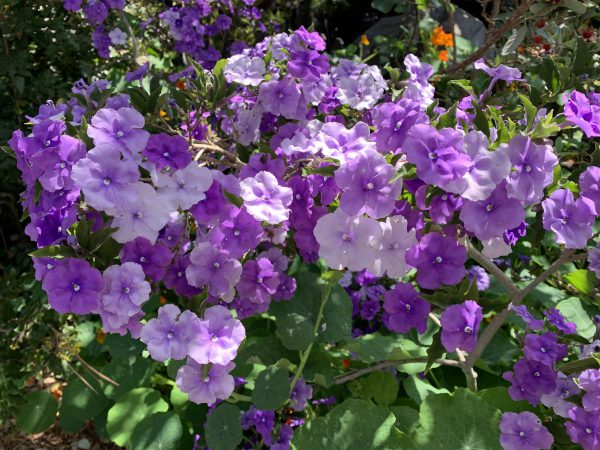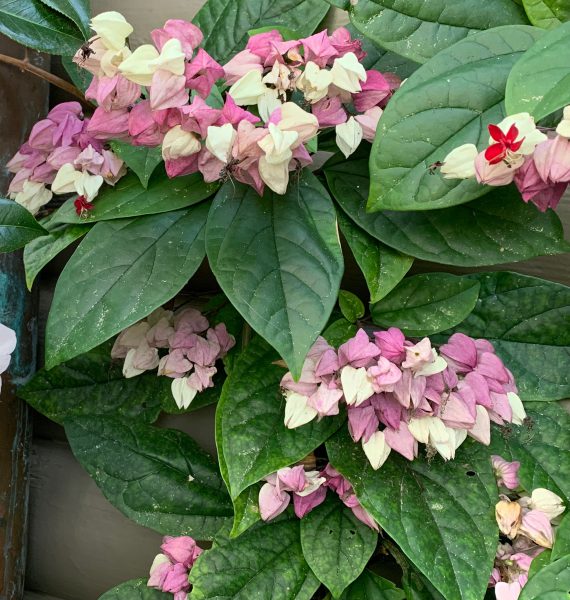Yesterday Today and Tomorrow
No, this column is not about historic preservation. For now, barring new events, everything to be said about Laguna Beach historic preservation has probably been said. No, “yesterday, today and tomorrow” doesn’t relate to history. It is a shrub that is in full bloom right now. The flowers start out the first day a deep purple, the next day they are lavender. Finally they are white. Thus the shrub joyfully shows all those colors at once, counting, in its own way, the passage of time

It’s always a surprise. As one of the carpenters who worked on our remodel years ago said, “Your plants are amazing. Some of them look like just a bunch of weeds and then all of a sudden—look at them!” Some of my clients weren’t patient enough and tore out the shrubs before they had a chance to reveal their unusual display. “They didn’t do well,” they explained.
To myself I say, “No, you didn’t wait long enough.”
I learned there is a psychology of choosing plants for people.
Planting a plant is not like putting a new sofa in your living room. With a sofa if you like it and it looks perfect where you have placed it, great. It’s perfect from the beginning, but the downside is from day one the only thing that can happen to the sofa is for it to gradually wear out. Plants are not perfect at all from the beginning, but they have an upside. They can grow to get more and more beautiful over time.
Having new plants is kind of like being a parent. That baby, that little kid, is not the perfect model child every parent imagines they will have. Parents must learn infinite patience. Some years ago my brother Frank and his family arrived at our house late in the day having driven straight through from Arizona. His youngest, less than two years old, was crying and crying. There Frank was for what seemed like hours sitting in the living room just holding her as she sobbed and screamed, on and on. An earache, a strange place, just being tired, who knows? But for me it was the image of patience and empathy, a lesson not to be forgotten.
There is a reward for patience—each child brings something unexpected, now she’s a physicist.
The plants that bring the unexpected beauty can be the most vulnerable to impatience.
Why do you rarely see a bleeding heart vine? (Clerodendrum Thompsoniae) This amazing vine produces three different displays. First white lantern-like bract that looks almost like a bougainvillea’s. Then a sweet red-petaled flower inside the opening bract. Finally the white bract turns pinkish purple. So why are they seen so seldom? Impatience again, and maybe hasty gardeners. The vine has a long rest period. (It needs time to prepare itself for making those terrific displays.) No leaves at all for several months. Looks dead. Chop it off. That’s the end of the bleeding heart vine. My client says, “It didn’t do well” or “It disappeared.”

There are some trees that one should never plant in small sizes—just because clients and gardeners think it’s a shrub and treat it that way, keeping it small forever. Metrosideros—New Zealand Christmas Tree is one. On one job the Metrosideros planted as a 36-inch box has grown into a nicely branched spreading tree. The others planted as five-gallon size for budget reasons are clipped into submission every week and are 3-foot diameter balls. It seems none of the gardeners imagine the beautiful trees they could become.
Then there’s the reliable and humble privet. If you see a clipped hedge chances are that there is a row of privet shrubs making up the boxiness. It’s so commonly seen as a hedge that no matter the intention of the design, it will be clipped into a hedge. Despite its great qualities as an informal screening plant, doing well in sun or shade, with glossy foliage and white flowers, privet will rarely be allowed to be itself. Unless I can stand guard over it, I must choose some other plant, one not associated with being hedged.
Instead of allowing impatience and prejudices to drive our decisions.
We could be treating plants—and the people around us—with consideration for the inherent potential of each, encouraging their best selves. We in turn, are in the process of becoming our best selves, yesterday today and tomorrow.
Ann is a landscape architect and former Laguna Beach mayor.




